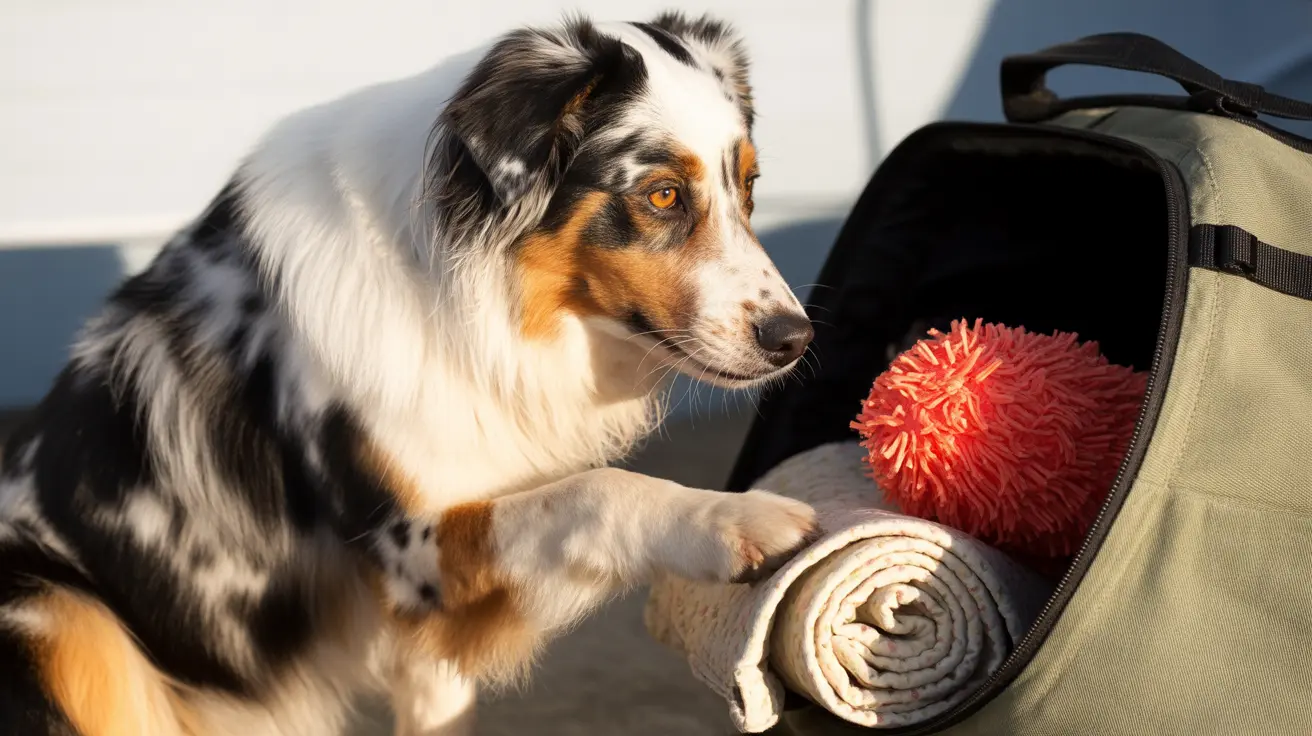Dog Flatulence Causes and Treatment: A Complete Guide to Managing Your Pet's Digestive Health
Dog flatulence is one of the most common digestive concerns that pet owners face, yet many don't fully understand when it's normal versus when it signals a more serious health issue. While the occasional release of gas is a natural part of your dog's digestive process, excessive or persistent flatulence can indicate underlying problems that require attention and proper management.
Understanding the root causes of dog flatulence causes and treatment options is essential for maintaining your pet's optimal digestive health. From dietary factors and breed-specific predispositions to more complex gastrointestinal disorders, numerous factors can contribute to excessive gas production in dogs. This comprehensive guide will help you identify potential causes, recognize warning signs, and implement effective treatment strategies to keep your furry companion comfortable and healthy.
Whether you're dealing with occasional episodes or chronic digestive issues, proper knowledge and proactive management can significantly improve your dog's quality of life while preventing more serious complications from developing.
Understanding the Science Behind Dog Flatulence
Flatulence in dogs refers to the excessive formation of gas in the stomach or intestines, which is then expelled through the anus. The medical term for this expelled gas is flatus, and while it's a normal part of the digestive process, it becomes problematic when it occurs excessively or is accompanied by other symptoms.
The gas formation process occurs when bacteria in your dog's digestive system break down food particles, particularly those that are difficult to digest. This bacterial fermentation is a natural part of maintaining healthy digestive flora, but when the balance of bacteria shifts or when certain foods provide excessive fermentable material, gas production can increase dramatically.
Normal flatulence serves an important physiological function by relieving pressure in the digestive tract. However, when gas production exceeds the body's ability to process it efficiently, it can lead to discomfort, bloating, and the characteristic symptoms that concerned pet owners notice.
Common Causes of Excessive Gas in Dogs
Dietary Factors and Food Sensitivities
Diet plays the most significant role in canine flatulence, with several specific factors contributing to increased gas production. Foods high in fermentable fiber, such as soybeans, peas, and beans, are particularly problematic as they provide substantial substrate for bacterial fermentation in the colon. These ingredients are commonly found in many commercial dog foods, especially those marketed as high-protein or grain-free options.
Lactose intolerance is another major dietary cause, as most dogs and cats cannot properly digest milk products. When dogs consume dairy, the undigested lactose ferments in the intestines, leading to both flatulence and potential intestinal upset. High-fat and spicy foods also contribute to digestive distress and increased gas production.
Eating spoiled food or poorly digestible diets can disrupt the normal bacterial balance in your dog's gut, leading to excessive fermentation and gas formation. Additionally, sudden changes in diet can shock the digestive system, as the established bacterial populations haven't had time to adapt to processing new ingredients.
Eating Habits and Physical Factors
How your dog eats can be just as important as what they eat when it comes to flatulence. Dogs that eat rapidly or gulp their food tend to swallow excessive amounts of air, a condition known as aerophagia. This swallowed air must eventually be expelled, contributing to flatulence frequency and volume.
Brachycephalic breeds—those with shortened facial structures like bulldogs, pugs, and boxers—are particularly susceptible to swallowing air while eating due to their anatomical differences. Their compressed airways and altered facial structure make it more difficult to eat without ingesting excess air.
Overweight, obese, and sedentary dogs also tend to experience more flatulence. Excess weight can put pressure on the digestive organs, while lack of physical activity reduces natural gut motility, allowing gas to accumulate rather than being processed efficiently through the digestive system.
Recognizing When Flatulence Becomes a Health Concern
Normal vs. Problematic Symptoms
Understanding the difference between normal and concerning flatulence is crucial for dog owners. Normal flatulence typically involves occasional gas expulsion with minimal odor and no accompanying symptoms. The dog remains comfortable, maintains normal appetite and energy levels, and shows no signs of distress.
Problematic flatulence presents differently and may include persistent, foul-smelling gas accompanied by clinical signs such as mild abdominal discomfort, visible bloating, and rumbling noises in the abdomen (borborygmus). These symptoms suggest that the digestive system is struggling to process food efficiently.
Red Flag Symptoms Requiring Veterinary Attention
Certain symptoms accompanying flatulence indicate underlying gastrointestinal disorders that require professional evaluation. These red flag symptoms include loose stools, diarrhea, vomiting, unexplained weight loss, lethargy, loss of appetite, and signs of abdominal pain such as hunched posture or reluctance to move.
When flatulence is caused by serious underlying conditions, these additional symptoms typically develop because the same factors disrupting normal digestion and causing gas also affect other aspects of gastrointestinal function. Early recognition and treatment of these warning signs can prevent more serious complications from developing.
Breed-Specific Considerations and Risk Factors
Brachycephalic breeds face unique challenges that make them more prone to flatulence. Their shortened nasal passages and compressed facial structure not only make breathing more difficult but also affect their eating patterns. These dogs often eat more quickly and with greater effort, naturally swallowing more air in the process.
The anatomical differences in these breeds also affect their ability to efficiently expel gas through normal belching, meaning more gas travels through the entire digestive tract and is expelled as flatulence. Owners of brachycephalic breeds should be particularly attentive to feeding methods and may need to implement specialized feeding strategies to minimize air swallowing.
Non-brachycephalic breeds can still experience significant flatulence, but the causes are more likely to be dietary or related to underlying health conditions rather than anatomical predisposition. Understanding your dog's breed-specific risks helps in developing targeted prevention and management strategies.
Diagnostic Approach and Professional Evaluation
When to Consult Your Veterinarian
Persistent or severe flatulence, especially when accompanied by other gastrointestinal symptoms, warrants professional veterinary evaluation. Your veterinarian will begin with a comprehensive medical history and physical examination to identify potential underlying causes and determine the most appropriate diagnostic approach.
The diagnostic process may include several types of testing depending on the severity and duration of symptoms. Fecal examinations can identify parasites or bacterial imbalances, while blood tests may reveal systemic conditions affecting digestion. In some cases, abdominal imaging or even biopsies might be necessary to rule out more serious conditions.
Conditions That May Require Medical Intervention
Several gastrointestinal diseases can present with flatulence as a primary symptom. Inflammatory bowel disease (IBD), colitis, pancreatitis, irritable bowel syndrome (IBS), intestinal parasites, and neoplasia all can cause excessive gas production along with other digestive symptoms.
Small intestinal bacterial overgrowth (SIBO) and pancreatic insufficiency are additional conditions that can significantly impact digestion and lead to chronic flatulence. These conditions require specific medical treatments and long-term management strategies that go beyond simple dietary modifications.
Effective Treatment Strategies for Dog Flatulence
Dietary Modifications and Management
Treatment for dog flatulence causes and treatment typically begins with dietary modification, which often provides the most significant improvement. Transitioning to highly digestible, low-fiber, and low-fat foods reduces the amount of fermentable substrate available to bacteria in the colon, thereby decreasing gas production.
When changing your dog's diet, gradual transitions are essential. Sudden dietary changes can worsen flatulence and cause digestive upset. A proper transition should occur over at least two weeks, gradually increasing the proportion of new food while decreasing the old food. This allows your dog's digestive system and bacterial populations to adapt slowly to the new ingredients.
Feeding small, frequent meals rather than one or two large meals can significantly reduce flatulence by preventing overloading of the digestive system. This approach also helps control eating speed naturally, as dogs are less likely to gulp their food when portions are smaller and more frequent.
Controlling Eating Behaviors
Managing how your dog eats is just as important as what they eat. Using slow-feeder bowls or puzzle feeders can help reduce the speed at which dogs consume their meals, thereby decreasing the amount of air swallowed during eating. These tools force dogs to work for their food, naturally slowing consumption and improving digestion.
For dogs that compete with other pets during meals, feeding them separately can reduce anxiety-driven rapid eating. Creating a calm, stress-free feeding environment helps promote proper digestion and reduces the likelihood of air swallowing.
Medical Interventions and Supplements
Medical therapy for flatulence often includes probiotics and prebiotics to promote a healthy gut microbiome. These supplements help restore the natural balance of beneficial bacteria in the digestive tract, improving overall digestive efficiency and reducing excessive fermentation.
Digestive enzymes may also be beneficial, particularly for dogs with pancreatic insufficiency or other conditions that impair natural enzyme production. These supplements help break down food more completely, reducing the amount of undigested material available for bacterial fermentation.
Certain supplements like activated charcoal and Yucca schidigera may help reduce the odor of flatulence, though they don't address underlying causes. These should be used under veterinary guidance and as part of a comprehensive treatment plan rather than as standalone solutions.
The Role of Exercise and Lifestyle in Digestive Health
Regular physical activity plays a crucial role in maintaining optimal digestive function and preventing flatulence. Exercise helps stimulate natural gut motility, encouraging the normal movement of food and gas through the digestive tract. This natural massage effect helps prevent gas accumulation and promotes healthy digestion.
Maintaining a healthy body weight through proper diet and exercise is essential for digestive health. Overweight dogs experience increased pressure on their abdominal organs, which can impair normal digestive function and contribute to gas retention. Regular exercise helps maintain healthy weight while promoting natural digestive processes.
The timing of exercise relative to meals is also important. Light activity after meals can help stimulate digestion, but intense exercise immediately after eating should be avoided as it can lead to digestive upset and potentially more serious conditions like bloat.
Advanced Diagnostic Tools and Personalized Treatment
Gut Microbiome Testing
Modern veterinary medicine now offers gut microbiome testing, which can identify specific bacterial imbalances contributing to digestive issues. This testing provides valuable information that can guide personalized dietary and supplement recommendations, allowing for more targeted treatment approaches.
Understanding your dog's unique bacterial population helps veterinarians recommend specific probiotics and dietary modifications that are most likely to be effective for your individual pet. This personalized approach often leads to better outcomes than generic treatment protocols.
Long-term Management Strategies
For dogs with chronic flatulence issues, developing a long-term management plan with your veterinarian is essential. This plan should address not only immediate symptom relief but also prevention of future episodes and monitoring for potential complications.
Regular follow-up appointments allow for adjustment of treatment protocols based on your dog's response and any changes in their condition. This ongoing partnership with your veterinary team ensures optimal management of your pet's digestive health throughout their life.
Prevention and Ongoing Care
Establishing Healthy Feeding Practices
Prevention of excessive flatulence begins with establishing healthy feeding practices from an early age. Feeding a balanced, high-quality diet appropriate for your dog's age, size, and activity level provides the foundation for good digestive health. Avoiding table scraps and high-fiber or highly fermentable foods helps prevent dietary-induced flatulence.
Monitoring your dog's feeding habits and making adjustments as needed ensures continued digestive health. This includes watching for changes in eating speed, appetite, or food preferences that might indicate developing issues.
Regular Health Monitoring
Keeping track of your dog's digestive patterns, including the frequency and characteristics of flatulence, helps identify problems early. Note any changes in gas production, odor, or accompanying symptoms, as these observations can be valuable information for your veterinarian.
Regular veterinary check-ups should include discussion of digestive health, even when no obvious problems are present. Early intervention for developing issues often leads to better outcomes and prevents more serious complications.
Frequently Asked Questions
- Q: How can I tell if my dog's flatulence is normal or a sign of a health problem?
Normal flatulence is occasional, has minimal odor, and doesn't cause your dog discomfort. Concerning flatulence is persistent, foul-smelling, and may be accompanied by symptoms like diarrhea, vomiting, abdominal discomfort, weight loss, or changes in appetite. If you notice these additional symptoms or if the flatulence suddenly becomes much worse, consult your veterinarian.
- Q: What foods should I avoid feeding my dog to reduce flatulence?
Avoid foods high in fermentable fiber such as soybeans, peas, and beans. Also eliminate dairy products since most dogs are lactose intolerant, and avoid high-fat or spicy foods. Table scraps and spoiled food should never be given to dogs as they can disrupt digestive balance and increase gas production.
- Q: Are certain dog breeds more prone to flatulence than others?
Yes, brachycephalic breeds (short-nosed dogs) like bulldogs, pugs, and boxers are more prone to flatulence due to their facial structure, which causes them to swallow more air while eating. However, any breed can experience flatulence due to dietary factors or underlying health conditions.
- Q: How long should I wait before seeing a veterinarian for my dog's flatulence?
If flatulence is mild and not accompanied by other symptoms, you can try dietary modifications for 1-2 weeks. However, seek immediate veterinary attention if flatulence is accompanied by vomiting, diarrhea, lethargy, loss of appetite, abdominal pain, or weight loss. Persistent, severe flatulence lasting more than a few days also warrants professional evaluation.
- Q: Can probiotics help reduce my dog's flatulence?
Yes, probiotics can be very helpful in managing flatulence by promoting a healthy balance of gut bacteria and improving digestive efficiency. They work best when combined with appropriate dietary modifications. Consult your veterinarian for recommendations on the most suitable probiotic products for your dog's specific needs.
- Q: Is it safe to give my dog over-the-counter gas relief medications?
No, you should never give your dog human medications without veterinary approval. Many over-the-counter gas relief products contain ingredients that can be harmful to dogs. Always consult your veterinarian before giving any medications or supplements to address flatulence issues.
- Q: How can I prevent my dog from swallowing air while eating?
Use slow-feeder bowls or puzzle feeders to reduce eating speed, feed smaller, more frequent meals, ensure a calm feeding environment, and consider feeding your dog separately from other pets to reduce competition and anxiety. For brachycephalic breeds, elevated feeding bowls may also help reduce air swallowing.
Conclusion
Understanding dog flatulence causes and treatment is essential for maintaining your pet's digestive health and overall well-being. While occasional gas is normal, persistent or severe flatulence often indicates underlying issues that require attention. The key to successful management lies in identifying the root cause, whether it's dietary factors, eating habits, breed-specific predispositions, or underlying health conditions.
Effective treatment typically involves a comprehensive approach combining dietary modifications, feeding behavior management, appropriate supplementation, and regular exercise. Working closely with your veterinarian ensures that any serious underlying conditions are properly diagnosed and treated, while preventive measures help maintain long-term digestive health. Remember that early intervention and consistent management strategies provide the best outcomes for dogs experiencing chronic flatulence issues.






